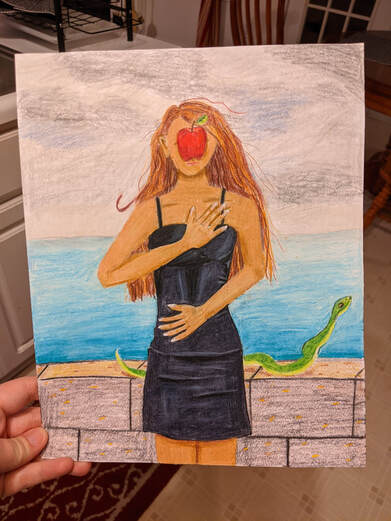|
-Rev Melissa Fain- Last week I picked up an art packet while subbing in an art class. It was all about parody art of famous work. I sketched through the pieces with the students, when I came across Son of Man. I had to do more, and I hope when you see my finished explanation, it will mean more. You'll see that I linked Son of Man with an analysis above. Below I'll give my analysis of my own piece, as well as a theological jump into the Creation Narrative. I highly suggest you click the link above and look at the original artwork first. I do not believe in a literal Garden of EdenWhy? There are multiple reasons. First, we have the issue of Moses. The first five books of the Hebrew Bible are attributed to Moses. It was believed, when he climbed up the mountain to talk to God, he wrote the Torah. That is why they are also called The Book of Moses. This belief, among Theologians, is contentious anyway because of a few reasons. One of them, I'll go into a little further down. Right here, let me say this: If Moses wrote the first five books of the Hebrew Bible, he also wrote about his own death and what happened directly after it. This, in and of itself, would not be a compelling reason for Biblical Literalists to follow my train of thought. They would see the power of God in giving Moses the story of his own death. I’m not going to go into whether knowing your own death is wonderous or horrific. Instead, I want you to consider the reality of what it would mean if Moses did write Genesis. If Moses wrote Genesis, it sets up a couple of potential scenarios. The first scenario is that Moses wrote down the spoken story that was passed down through the generations. This means the story didn’t have to be literally correct, as long as it was theologically correct to the people telling it. Truth comes in many forms, and not all of them are historical. Once again, not a scenario for Biblical literalists. If Moses wrote it, it was a story that was already incredibly old before it was finally written down. It didn’t have to be note for note, a recreation of how God created the Heavens and Earth. The second scenario is that Moses asked God how it all began, and God told the story as a parent would tell her child. Why would God talk to Moses about galaxies and the vastness of the universe, when Moses’ entire universal view was still that the Earth was the center of the universe? If we were told Moses saw the entirety of God, and not just the back side, sure, God opened Moses’ eyes to the wonders of all of us being made of stars. God didn’t though, so I don’t believe Moses knew. That means it’s okay to not see Genesis 1-3 as a literal retelling of how God made everything. FYI- I don’t believe Moses wrote the book of Genesis. Second, we have an authorship problem. This one is difficult to take in if you never had a minister open enough to talk about it. The Hebrew Bible, based on textual clues, were written by multiple groups of people. I’m going to go into two issues as it arises in the Creation narratives. The first issue is that there are creation narrativeS. (Yes, the ‘S’ is capitalized on purpose.) Just like there are multiple versions of Noah’s Ark, and no, I’m not talking about Gilgamesh or the multitude of flood stories across multiple cultures. I’m talking about multiple stories in the Bible. The first creation story goes from Genesis 1:1-2:4. The second story goes from Genesis 2:5-3:23. Like Noah’s Ark, the stories do not fit seamlessly. In the second story, humanity is created before plants, while in the first story humanity is not created until day 6. I just have a very difficult time believing God wanted us to do the mental gymnastics required to make the stories work together. I tend to believe they sit together, not as literal tellings of creation, but as stories of how ancient people saw the world. The second issue is that those narratives have different authors. There are times I am given a note, and the author doesn’t present him or herself in the text. I have to pull clues from the note in order to decide who sent the message. There are a few people who call me, “Lady.” These are secretaries from different middle schools, and also a friend at one of those schools. Then I can take clues from the note itself, and where I’m reading it to figure out the rest. Only my closest friends call me “Mel.” Only my sister calls me “Issa.” Only students and teachers call me “Ms. Fain.” The sixth grade hall at Austin Middle School just calls me “Fain.” And the list goes on. What names people are called help people know who wrote texts, and in this case, very very old texts. In the Bible this is true as well. In Genesis, the name attributed to God changes when the story changes. Most of us don’t realize as readers of translated text, that multiple names are used in the Hebrew Bible when we simply get ‘God.’ In the case of Genesis 1-3 the name of God changes from Elohim to Yahweh just as the first Creation narrative wraps up and the new one begins. Elohim, to the Hebrew people, means Creator God. Yahweh is not a name at all, but a placeholder. When one reads “Yahweh,” they should instead say “Adoni,” which means “Lord.” This change in name happens as the style of writing changes, or the stories begin to retell themselves. These are literary context clues, and point to multiple authors across many generations. All of this is why I don’t believe there was a literal Eve. This begs the question, why did I draw her then? My drawing: EveI also don’t think the forbidden fruit was an apple. Apples, especially the way we know them, wouldn’t have even existed in ancient Mesopotamia. It was Thomas Payne’s use of an apple as the forbidden fruit in his book “Age of Reason,” that caused me to put his writing down. This is actually the reason I used an apple in my drawing.
Magritte named his original art, “Son of Man.” With the “Human One,” or “Son of Man,” being Jesus Christ, it’s important to know the original is a self portrait. Just knowing the name makes me incredibly uncomfortable. Here’s a guy, subtly calling himself Christ, with the forbidden fruit in front of his face. The apple sits in front of his face, because it makes us want to remove it. We wouldn’t care if the apple sat on the wall. We care because we are told this is a self portrait, and his face is being obscured by a fruit. Also, he put the ocean behind him. Whether he realized it or not, the oceans to the Ancient Hebrew people were the place of uncreation. In Genesis, God didn’t create everything, but left chaos in the waves. Also, according to scripture, the waters in the sky will not fall until Noah’s Ark, so it’s also fitting that the sky is filled with clouds. With Eve being my subject then, it only makes sense that all of Eden would be on the opposite side of the frame. We’re forcing our gaze on her, when all of God’s creation is just behind us out of view. In my drawing, Eve doesn’t want you looking at her the way we all look at her. Naked. Her hands try to cover her body, not because God is looking, but because we are. Her right hand sometimes flips out, depending on the distance you look at it. It makes her both guarding and protecting. She’s afraid of you. Meanwhile, she’s not afraid of the snake just behind her. She is not afraid of the chaos held back by a short wall. She’s not afraid of God’s wrath laying heavy in those clouds. Those are all God. She fears us, and what we’ve turned her into. It’s iconography, but it’s all wrong. Icons are supposed to be able to look at you, but the sin keeps our eyes from meeting. Her sin or our sin? It’s a great question, because the apple would be ours, not hers. The lines should be up and down to connect heaven and earth, but the lines run sideways, breaking that connection. You should leave the piece no longer wanting to objectify her, but to see yourself, and want to turn around and face God. Then you can ask yourself this question. Can you? |
Categories
All
Archives
October 2023
|




 RSS Feed
RSS Feed